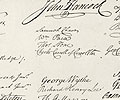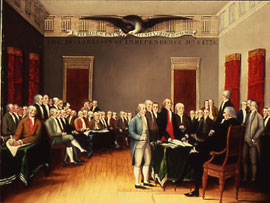The Signers
"And for the support of this Declaration, with a firm reliance on the protection of divine Providence, we mutually pledge to each other our Lives, our Fortunes and our sacred Honor."
The Continental Congress was the government of the thirteen colonies and, later, of the new nation, from 1775-1788. The fifty-six men who signed the Declaration of Independence were well educated, prosperous, and respected in their communities. Merchants, planters, doctors, and lawyers, most were between thirty and fifty years of age (the youngest was twenty-six; the oldest, seventy). All knew that by attaching their names to what the British considered a treasonable document, they risked lives, liberty, and property. As Benjamin Franklin famously remarked to his fellow delegates, "We must all hang together or most assuredly we shall all hang separately." (BF Papers, v22, p485-6 notes). Read more about some of the consequences.
Only John Hancock of Massachusetts as President of the Continental Congress and Secretary Charles Thomson signed the first copy on July 4. This was sent immediately to the official printer for Congress to be produced for wide distribution. What subsequently happened to the original is unknown.
The majority of the delegates in Congress signed the Declaration in Philadelphia on August 2, 1776. Those who were not present on that day signed during the following months. Most of the members of Congress formally signed the Declaration, but three did not sign at all.
- May 15 1776
-
The Virginia Convention
The Virginia Convention empowered its delegates in the Continental Congress to vote for independence.
Read More - June 7 1776
-
Acting under the instructions of the Fifth Virginia Convention, Richard Henry Lee moved in Congress "that these United Colonies are, and of right ought to be, free and independent States."
- June 11 1776
-
Committee Appointed
A committee was appointed to prepare a declaration of independence.
Read More - June 28 1776
-
Thomas Jefferson's draft, including amendments by the committee, was presented to Congress.
- July 2 1776
-
Congress voted for independence - 12 for, none against, one abstention.
- July 4 1776
-
Declaration of Independence Approved by Congress
The Declaration of Independence was approved by Congress - 12 for, none against, one abstention
Read More - August 2 1776
-
Engrossed on parchment, the Declaration is ready to be formally signed by Congressmen
- September 1776
-
Elbridge Gerry of Massachusetts and Lewis Morris of New York sign the Declaration.
- November 1776
- After January 18 1777
-

Thomas McKean of Delaware signs the Declaration
View the Signatures
Featured signers:
- John Adams (Massachusetts)
- Carter Braxton (Virginia)
- Charles Carroll (Maryland)
- Button Gwinnett (Georgia)
- Benjamin Franklin (Pennsylvania)
- John Hancock (Massachusetts)
- Benjamin Harrison (Virginia)
- Thomas Jefferson (Virginia)
- Francis Lightfoot Lee (Virginia)
- Richard Henry Lee (Virginia)
- Thomas McKean (Delaware)
- Arthur Middleton (South Carolina)
- Thomas Nelson (Virginia)
- George Wythe (Virginia)
For biographies of all the signers go to Colonial Hall.
